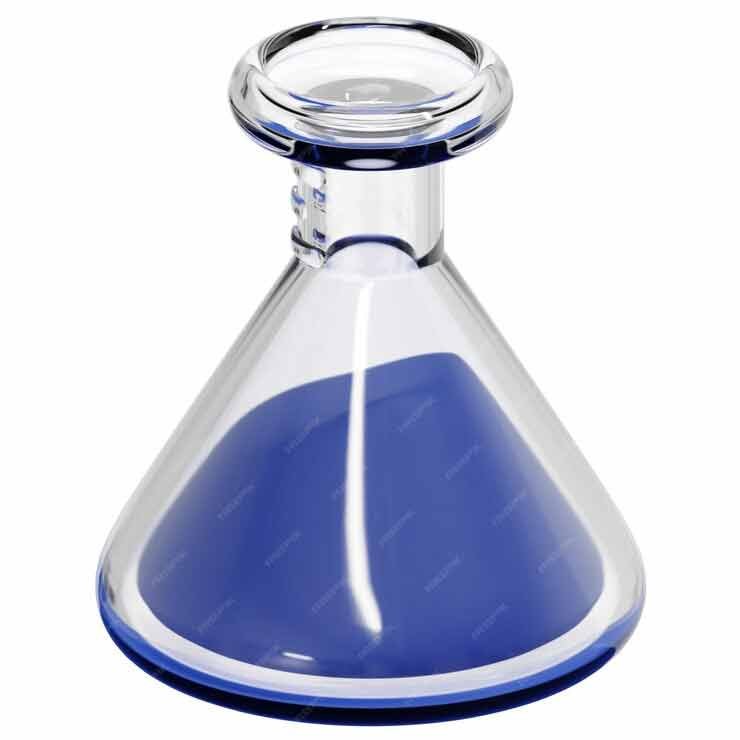Table of Contents
Introduction
The Erlenmeyer flask stands out as an essential tool for scientists and researchers. Recognizable by its conical body and narrow neck, various scientific applications. This article delves into the design, history, uses, handling, and advantages of the Erlenmeyer flask, providing a comprehensive understanding of its significance in the laboratory setting.
The Origin of the Erlenmeyer Flask

The Erlenmeyer flask owes its name to the German chemist Emil Erlenmeyer, who introduced this innovative piece of glassware in 1860. Erlenmeyer’s design aimed to improve upon existing flasks by creating a vessel that combined stability with versatility. The conical shape and narrow neck were deliberate choices to facilitate mixing, heating, and safe handling of chemical solutions.
Design Features: Conical Body and Narrow Neck
Effective mixing: The wide base is angled upwards, allowing liquids to flow easily without the risk of spilling.
Good stability: The wide base provides a low of gravity, reducing the risk of tipping.
The short neck serves several purposes:

Reduced evaporation: A small opening reduces contact with the evaporating liquid.
Controlled pouring: The narrow neck allows liquids to pour evenly.
Compatible with stoppers: The narrow opening can be closed with a stopper, which prevents contamination and allows for storage.
Durability: Less likely to break than glass.
Lightweight: Easy to handle and store, especially in field conditions.
Erlenmeyer bottles are made of borosilicate glass.
Heat resistance: Can withstand high temperatures without cracking.
Chemical inertness: ensuring the purity of solutions.
Recently, plastic Erlenmeyer flasks have become available, which have the following advantages:
Advantages Over Other Laboratory Flasks
Compared to other flasks, the Erlenmeyer flask offers distinct advantages:
- Reduced Risk of Spillage: The conical design makes it easier to mix contents without splashing.
- Versatility: Suitable for a wide range of applications, from mixing to heating and storage.
- Ease of Handling: The narrow neck provides a convenient grip, and the flask’s shape allows for easy clamping onto stands.
Proper Handling and Maintenance
· Cleaning: Rinse immediately after use to prevent residue buildup. Use appropriate cleaning agents and brushes to reach the interior surfaces.
· Inspection: Regularly check for cracks or scratches, especially if using glass flasks, as these can compromise integrity.
· Storage: Store flasks in a secure location to prevent accidental tipping or breakage.
Selecting the Right Erlenmeyer Flask
· Capacity: Available in various sizes, ranging from a few milliliters to several liters. Select a size appropriate for your application.
· Material: Decide between glass or plastic based on the nature of your work. Glass is ideal for high-temperature applications, while plastic offers durability.
· Graduations: Some flasks come with volume markings. Ensure they are clear and appropriate for the required measurement accuracy.
Common Uses in the Laboratory
· Titration: The narrow neck accommodates burettes, and the conical shape allows for easy mixing of reagents.
· Culturing Microorganisms: Provides an ideal environment for growing bacterial or yeast cultures due to its shape and the ability to seal the opening.
· Heating Solutions: The flask’s design allows for uniform heating of liquids on various heat sources.
· Storage: When paired with a stopper, it serves as a temporary storage vessel for chemical solutions
Safety Considerations
· Avoid rapid temperature changes: Sudden heating or cooling can cause glass flasks to crack.
· Use appropriate stoppers: Ensure stoppers fit securely to prevent leaks but avoid over-tightening, which can cause breakage.
· Handle with Care: Even plastic flasks can crack under pressure or impact. Always handle with appropriate care.
FAQs
Why is the Erlenmeyer flask preferred over beakers for mixing solutions?
The conical design of the Erlenmeyer flask allows for efficient mixing by swirling, reducing the risk of spillage compared to the straight-sided beaker.
Can Erlenmeyer flasks be used for accurate measurements?
While some Erlenmeyer flasks have graduation markings, they are generally not used for precise measurements. For exact volumes, volumetric flasks or graduated cylinders are preferred.
What is the purpose of baffled Erlenmeyer flasks?
Baffled flasks have indentations that enhance hold to shaking or mixing and oxygen transfer, making them ideal for culturing aerobic microorganisms.
How should I clean my Erlenmeyer flask?
Cleaning agents. For stubborn residues, use brushes designed for laboratory glassware, ensuring all contaminants are removed
Conclusion
The body and narrow neck Erlenmeyer flask remain a staple in laboratories worldwide due to its thoughtful design and versatility. Its unique shape facilitates efficient mixing, heating, and storage of solutions, making it an indispensable tool for scientists across various disciplines. By understanding its features, proper usage, and maintenance, one can fully harness the benefits of this essential piece of laboratory equipment.

Innovative concepts! I’ve found the street art aesthetic in Sprunki Game particularly inspiring for creating urban-inspired soundscapes.